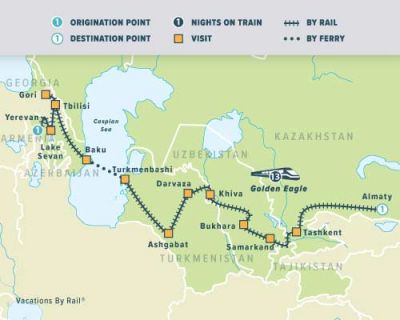Day 1 - Yerevan
Upon arrival at Yerevan International Airport you will be met and transferred to the centrally-located Armenia Marriott Hotel (or similar), where we stay for one night. Tonight we enjoy a welcome dinner at our hotel, whilst you meet your fellow travellers and look forward to the journey across six countries of the South Caucasus region and Central Asia.Why not extend your stay in Yerevan with additional nights before the tour to explore more of the city and region at your leisure?
Day 2 - Yerevan
The Yerevan skyline is dominated by Mount Ararat in nearby Turkey, with its snow covered peak towering in the distance. Yerevan has a rich history and was occupied as early as 6,000 BC. The fortress of Erebuni was erected there in the 8th century BC. Seized by a succession of conquerors, the city later passed back and forth between the Turks and the Persians until 1827, when it was taken by Russia. It became the capital of Soviet Armenia in 1920 and following the demise of the Soviet Union, the capital of the new nation of Armenia. Our day's touring will take us 23 miles (37 km) out of Yerevan to the ancient Geghard Monastery. The beautiful monastery contains a number of churches and tombs, many of them cut into the rock. The complex of medieval architecture is set into a landscape of great natural beauty, surrounded by towering cliffs at the head of the Azat Valley.
We'll also visit the 1st Century pagan temple of Garni, built to worship the Sun God Mitra. We'll explore the remains of an ancient fortress, palace and baths there. Back in Yerevan city we'll visit the Cascade giant stairway and inside it the Casfejian Museum of Modern Art. In the evening we board our Golden Eagle private train and start our rail adventure to Almaty.
Day 3 - Lake Sevan & Dilijan
Our train takes a scenic route today around the stunning Lake Sevan and we make a short stop to walk to the beach for a photo opportunity. Along with Lake Van and Lake Urmia, Sevan was considered one of the three great lakes of the historical Armenian Kingdom, collectively referred to as the Seas of Armenia; it is the only one within the boundaries of today's Republic of Armenia. We'll continue to Dilijan to visit the nearby Monastery of Haghpat, built between the 10th and 14th centuries. Its beautiful location in dense wood in the gorges of two small mountain rivers make an atmospheric backdrop for St. Astvatsatsin Church, its most important building. We'll have an Armenian cognac reception at Avan Dzoraget Hotel on the Debed River, nestled among the forest-covered hills and rocky slopes of the Caucasus Mountains.
Day 4 - Tbilisi
Heading into Georgia, we visit Tbilisi. Hemmed in by the Surami Range, the city extends for 17 miles (27 km) along the banks of the River Kura. Despite the wars and fires which caused innumerable changes in the topography of Tbilisi, the old part of the city still retains much of its original layout, a spider's web of narrow winding streets and alleyways.
Historical sites we visit include the 13th century Metekhi church, a cross cupola church which forms part of the Royal Residential complex, and the 5th century Sioni Cathedral, the main church of Tbilisi. We'll also visit the recently built Holy Trinity Cathedral, one of the largest Orthodox churches in the world and take a walking tour of the old town and Rustaveli Avenue. Here we will see the Great Hall of the Georgian Philharmonia, built in 1969-71, which has been acknowledged as one of the finest public buildings since the Second World War. We'll see the treasures of the city housed in the Janashia Museum of Georgia.
Day 5 - Telavi
Today we explore the beautiful Kakheti region, which borders the Great Caucasus Mountain range. This region is known as a birthplace of Georgian viticulture and wine-making. We tour the Tsinandali country estate of the Alexandre Chavchavadze family with a marvellous garden, house-museum, park and winery dating back to the 19th century, located near Telavi, a couple of hours' drive from Tbilisi.
Day 6 - Gori, Uplistsikhe Cave City & Mtskheta
Gori is one of the oldest cities in Georgia, founded in the 7th century AD as Tontio. Joseph Stalin, the Soviet leader, was born here in 1879 and he spent his childhood years in the city and later (1888-94) studied at its theological seminary. The small house where Stalin was born is preserved under a canopy outside the huge columned palace-like building that houses the Stalin Museum. To the side of the museum is Stalin's private railway carriage. The museum is filled with interesting photographs of the man responsible for more deaths and suffering than any other human being. From the town we will go directly to Uplistsikhe where we will have a private performance of traditional Georgian polyphonic singing.
The famous cave city of Uplistsikhe dates from the 6th century BC and is first mentioned in the chronicles of the 1st century AD. Carved into rocky plateau we find huge echoing halls, meandering corridor-streets, chambers for pagan worship and even the remains of Georgia's oldest theatre, complete with auditorium, stage and orchestra pit. Like the other cave-towns of Georgia, it is rooted in the prehistoric traditions of the peoples of the Near East. On one side the fortress was protected by the Mtkvari and an almost vertical rock face, on the other, by powerful fortifications. Its strategic position on the approaches to Gori and, in particular, its strong defences made it possible to control the surrounding terrain. There were numerous attempts to destroy Uplistsikhe. Only in the 13th century, however, did the hordes of Genghis Khan's son Khulagu succeed in doing so, after capturing and destroying many fortresses in Transcaucasia with the help of siege machines. The 5,000 inhabitants of Uplistsikhe perished and life ended forever in the fortress. Late afternoon we visit the city of Mtskheta, Georgia's Old Capital. Due to its historical significance and numerous ancient monuments, Mtskheta became a UNESCO World Heritage Site in 1994.
Day 7 - Baku
Baku, capital of Azerbaijan, lies on the western shore of the Caspian Sea and the southern side of the Apsheron Peninsula, around the wide, curving sweep of the Bay of Baku. The bay, sheltered by the islands of the Baku Archipelago, provides the best harbour of the Caspian Sea, while the Apsheron Peninsula gives protection from violent northerly winds. Baku derives its international importance from its huge oil industry. The core of present-day Baku is the Old Town, or fortress, of Icheri-Shekher. Most of the walls, strengthened after the Russian conquest in 1806, survive, as does the 90 ft (27 m) tower of Kyz-Kalasy (Maiden Tower, 12th century). The walled old town is highly picturesque, with its maze of narrow alleys and ancient buildings. These include the Palace of the Shirvan-Shahs, now a museum, the oldest part of which dates from the 11th century. Also of the 11th century is the Synyk-Kala Minaret and Mosque (1078-79).
Other notable historic buildings are the Law Court (Divan-Khan), the Dzhuma-Mechet Minaret, and the mausoleum of the astronomer Seida Bakuvi. Around the walls of the fortress, the regular streets and imposing buildings of modern Baku rise up the slopes of the amphitheatre of hills surrounding the bay.
We stay at the five-star Four Seasons Baku for two nights, while our train is loaded on the ferry to cross the Caspian Sea.
Day 8 - Baku
This morning we offer a Freedom of Choice tour to Gobustan Rock Art Cultural Landscape. Located 40 miles (64 km) from Baku on the west bank of the Caspian Sea, Gobustan is an outstanding archaeological site of more than 6,000 pre-historic rock engravings. The area also features the remains of inhabited caves, settlements and burials. This is followed by lunch overlooking the Caspian Sea. Returning to the city in the afternoon, you can choose to enjoy free time in the city or visit a local theatre. Dinner will be held in a traditional local restaurant this evening.
NB: Early morning our train is loaded onto a cargo ferry for a 12-14 hour crossing of the Caspian Sea from Baku to the town of Turkmenbashi. Formerly known as Krasnovodsk, it is the western terminus of oil and natural gas pipelines and of the Trans-Caspian Railway, which links the Caspian region with central Asia.
The cargo ferry has limited passenger facilities with basic cabins and catering, and the adventurous amongst the group can choose to travel on the ferry with our train. Upon arrival at the port at Turkmenbashi our train will be offloaded and you will travel overnight to Ashgabat (this option needs to be requested at the time of booking the tour).
Day 9 - Ashgabat
Following breakfast we take a morning flight to Ashgabat. The capital of Turkmenistan is known as the ‘Las Vegas of the Kara Kum'. Situated between the Kara Kum desert and the Kopet Dag mountain range, Ashgabat is a relatively modern city built upon the ruins of the Silk Road city of Konjikala and the Soviet city built after the devastating earthquake of 1948.
The city's extravagant fountains, golden domes and towering modern buildings appear strangely incongruous in this desert setting. Highlights on our visit include a trip to the National Museum and Kipchak Mosque. Stay overnight in Oguzkent Sofitel hotel (or similar).
Day 10 - Darvaza
The Golden Eagle makes a brief scheduled stop at Ichoguz, where we have the option to leave the train and make a short journey to Darvaza's famous burning gas crater, a spectacular sight best seen at night. Located in the middle of the Kara Kum desert where the area is rich in natural gas, the 70 metre-wide crater is known by the locals as the ‘Door to Hell' and has been burning for over 40 years. A unique experience that is not to be missed.
Day 11 - Khiva
Our train travels towards Urgench, from where we transfer to the ancient city of Khiva, founded 2,500 years ago. As one of the Silk Road's most important trading posts and now a World Heritage Site, it lies at the crossroads of the routes between Mongolia, Russia, China and Persia. A truly magnificent sight to behold, it rises out of the desert to reveal a wealth of impressive architecture. Stepping back in time, we discover its impressive mosques, bazaars and minarets within Khiva's ancient walls.
Day 12 - Bukhara
Bukhara is quite simply outstanding. Like Khiva, UNESCO sponsored the renovation of much of the city for its 2,500th anniversary in 1999. The most enjoyable aspect of this city is to just immerse oneself in the atmosphere of this unique and ancient city and re-live some of its fascinating history at the crossroads of Asia. The main highlight of this wonderful tour is a visit to The Ark, a fortified residence of the Emirs of Bukhara - the despotic and ruthless leaders who ruled until Soviet times. We then travel out of the city to experience the Emir's enchantingly named, ‘Palace of the Moon and Stars'.
Day 13 - Samarkand
Just the mention of Samarkand instantly conjures up evocative images of the Silk Road, more so than any other town. Founded in the 6th century BC, Samarkand's stunning architecture hints at its former status as one of the most important cities in Asia and is particularly noted for its architectural remains from the 14th to the 17th century, when it flourished as the fabled capital of the Mongol empire of Timur and his successors. Today we will visit some of its most significant sites including Registan Square, the refined elegance of the beautifully proportioned Bibi Khanum Mosque and the Ulag Beg observatory, one of the earliest Islamic astronomical observatories built in 1428. Before dinner we will return to the now illuminated and awe-inspiring Registan Square.
Day 14 - Tashkent
Tashkent is the capital city of Uzbekistan and we spend time touring this modern Soviet-style city which was rebuilt following the devastating earthquake of 1966. Our tour of the city includes the Old Town, where traditional homes and religious buildings line the narrow streets and here in a small library we'll be privileged to see one of Islam's most sacred relics - the world's oldest Koran. This is followed by a visit to the Railway Museum and the Museum of Applied Arts. This evening we enjoy our Farewell Dinner onboard the Golden Eagle as we head overnight to our final destination of Almaty.
Day 15 - Almaty
This morning we arrive into Almaty, our final destination and bid farewell to the Golden Eagle. Today we will take a tour of Almaty including a visit to Panfilov Park, located in the heart of the city, and home to the Zenkov Cathedral, a 19th century Russian Orthodox Church made entirely of wood. Overnight we stay for one night at the InterContinental hotel (or similar).
Day 16 - Almaty
Following breakfast you will be transferred to Almaty Airport for your onward flight. Why not extend your stay in Almaty with additional nights to explore more of the city and surrounding region at your leisure?




 Destination & Sightseeing
Destination & Sightseeing ITINERARY
ITINERARY

